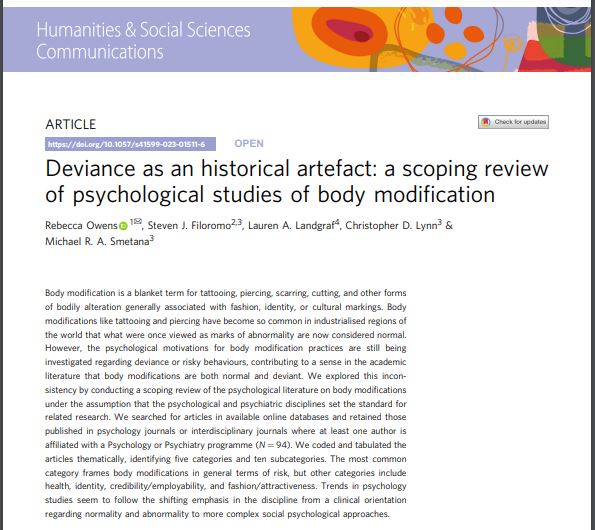|
Our new paper mentioned in the previous post is out, Open Access, in the Nature subsidiary journal Humanities & Social Science Communications. We're pretty stoked to have open access in a Nature journal. Is that big time? It is in my head!
Furthermore, I'm really proud of the students in my lab who stuck in there for Zoom meetings over the course of a year as we figured out how to do a scoping review, write it up, and get it published. Here is the DOI for the paper, where everyone can read it: https://www.nature.com/articles/s41599-023-01511-6
0 Comments
 This absurd headline was circulating while we wrote this piece, so we worked it into the article to show how some people apparently think. This absurd headline was circulating while we wrote this piece, so we worked it into the article to show how some people apparently think. My friend Becci Owens, Associate Professor of Psychology at University of Sunderland specializing in evolutionary psychology, had started working on a scoping review of psychological studies of body modification a few years ago but was stalled. I volunteered my lab to help her finish it. It took us about a year to discover that a "scoping review" is a real thing and not another word for a systematic review. After developing a coding system for the corpus of articles Becci had gathered, I googled scoping reviews and found the articles by Nunn like this one that describe scoping reviews in detail and realized that I'd led us all astray for a year. When we refocused on what a scoping review actually is, it became apparent that we simply needed to describe the basic patterns of how psychology studies of tattooing have been conducted. When we started, we noticed that so many of the studies looked for correlations between tattooing and negative personality traits and risk behaviors, despite the fact that most of the same articles and other contemporary sources note that no correlations between tattooing and negative personality traits how been found and that the primary correlations are with openness to experience and youth. So, our secondary objective was to try to understand why so many studies reify tattoo stigma by studying it as though it were a negative behavior and trying to understand causes of such poor behavior. In examining the group of studies that included tattooing as a "stigma" variable in this way (the largest category by far), it became clear that there was a temporal factor. Early studies were looking at penal and mental health populations, seeing lots of tattoos among patients relative to the general population, and trying to determine if marking the self is some aberration of fragile identities. Later studies seemed to indicate that tattooing itself is not a negative behavior but let's just throw it in anyway because we wonder if it might be a useful way to identify people at risk for mental fragility in the general population. But, though I paraphrase, what the hell is that anyway? I have long argued that such studies should just use the Big 5 Personality Inventories because what they're interested in is not risk-taking behavior so much as openness to experience. It appears that by the 2000s, scholars such as Viren Swami had laid to rest with explicit studies saying that all tattooed and non-tattooed people are the same, but even then his titles were ambiguous, leading people to potentially think there are differences if they don't read further (which, shocker, many people don't). Anyway, it became apparent that studies shifted from the above to social psychology studies that look at tattooing in much more interesting ways, such as how tattooing can have different meanings or impacts depending on the type of job you have or how tattooing may intersect with multiple marginalities to influence how people are treated in healthcare settings. These more granular studies are much more interesting. When we looked at the history of the discipline of psychology, the studies we note start after the first renaissance, which was much more recent than generally assumed--tattoos were only out of fashion for about 15-20 years. The pattern of psychology studies also follow the general patterns for research foci in the field of psychology. As of earlier this month, the article entitled "Deviance as an Historical Artifact: A Scoping Review of Psychological Studies of Body Modification" researched and written by Becci, me, Alex Landgraf, Steve Filoromo, and Mike Smetana, has been accepted for publication by Humanities and Social Sciences Communications. Click here to read a preprint of the whole paper. |
Christopher D. LynnI am a Professor of Anthropology at the University of Alabama with expertise in biocultural medical anthropology. Archives
May 2023
Categories
All
|


 RSS Feed
RSS Feed
